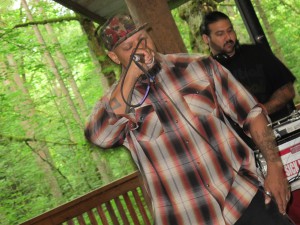In June 2014, six Oregon artists delivered special presentations about the history and cultural significance of their crafts and traditions at state parks across Oregon. Folk Arts in the Parks was sponsored by the Oregon Parks and Recreation Department (OPRD) along with the Oregon Folklife Network, the Oregon Arts Commission and the Oregon Cultural Trust. With the help of Parks and OFN staff, this diverse group of artists engaged with audiences through demonstrations, Q&A, and community conversation.
June 7th: Barbara Nelson
We kicked off FAIP at Emigrant Springs State Park near Pendleton. Cowboy poet and songwriter Barbara Nelson played an evening show in a beautiful indoor facility, delighting audience members young and old with her stories and songs. You can check out Barbara’s music at http://barbaranelsonmusic.com.
June 14th: Grupo Condor
On Saturday, June 14th, Latin American folk band Grupo Condor performed at L.L. “Stub” Stewart State Park near Portland. With a backdrop of pine, musicians Gerardo Calderon (guitar), Nelson Salazar (flute) and Nelda Reyes (percussion) kept the rain away with their songs. Grupo Condor’s energy was infectious and they drew a large crowd of park attendees during their afternoon performance. Gerardo did a wonderful job explaining the regional origins of the songs and instruments. You can learn more about Grupo Condor at http://grupo-condor.com/index.html.
June 15th: Alex Llumingquinga Perez
Andean flute maker and player Alex Lluminquinga Perez wowed the crowd at the historic Vista House at Crown Point with his musical talents and hands-on demonstration. His performance and display of traditional Andean instruments (wind and string) drew many spectators; Alex’s wife even performed a traditional dance accompanied by his music. Alex provided in-depth information as to how each instrument in his collection was made, and the activity to “make-and-take” home your own flute proved extremely popular with the children in the audience!
June 21st: Roberta Kirk
Roberta Kirk (H’Klumaiyat), a member of the Confederated Tribes of Warm Springs, demonstrated traditional Wasco beadwork with the help of her granddaughters at Milo McIver State Park in Estacada, OR. Roberta displayed a beautiful collection of Powwow outfits that she had designed and beaded. Each of Roberta’s intricate designs has symbolic and personal significance; all completed pieces will be passed down to family members to provide inspiration for the continued practice of the art form. During the presentation, the audience was treated to an oral account of Roberta’s people and family, learning the history and uses of Wasco beading techniques and materials through hands-on participation.
June 21st: Julie Johnson
Julie Johnson, a member of the Burns Paiute, spoke about various Powwow traditions, regalia, and dances at Wallowa Lake State Park. Julie shared her extensive knowledge about Fancy Shawl Dance, Butterfly Dance, and Jingle Dance, but the audience of curious campers and hikers were especially engaged when she and her daughters taught dance movements. Julie says that “the drum is the heartbeat of our people” and is always seeking balance between the physical and spiritual sides of dance. As a tradition bearer, she has passed this knowledge on to her four daughters, all of whom helped her to demonstrate and invited the other children in the audience to try out various steps. This event celebrated family and the sharing of knowledge across generational and cultural boundaries.
June 29th: Mic Crenshaw
In our final presentation of the month Mic Crenshaw of Portland came to Tryon Creek to entertain visitors with a hip-hop performance, stories, and discussion. The forest canopy was the perfect setting for Mic’s lyrics about the importance of environmental and social activism. Mic shared a deep knowledge of the foundation of his art form: in community conversation, raising important issues for needed dialog. He lamented the music industry’s commercialization of hip-hop that is about violence, drugs, and misogyny. Mic Crenshaw foresees a future where hip-hop returns to everyday people who use it to reconnect with community through rhythmic expression about our priorities, so we can remember that we are not individuals struggling alone, but we are a united humanity seeking good work, a healthy planet, and thriving communities.
The success of Folk Arts in the Parks demonstrates the diversity and vitality of OFN-sponsored public folklife programming across the state. If you are interested in integrating similar folk and traditional arts presentations into your classroom or organization’s event schedule, please contact us at ofn@uoregon.edu.



